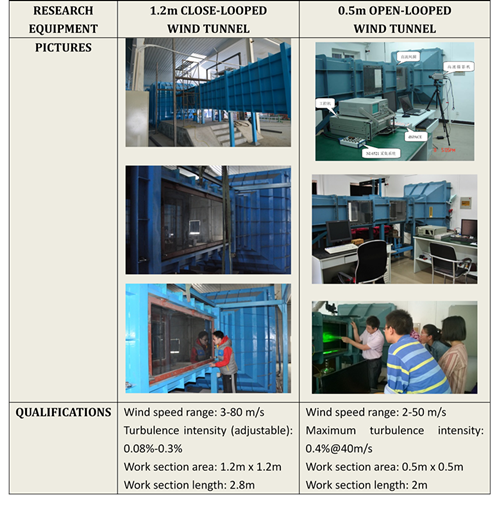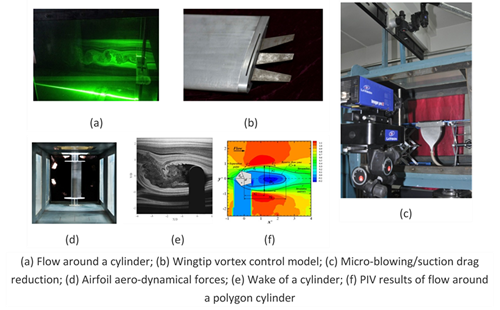INTRODUCTION
Institutes of Fluid Mechanics of Tsinghua University currently possess two wind tunnels for teaching and researching purposes. The first one is located in Tsinghua University main campus, which is an open-loop low-speed wind tunnel. The maximum wind speed is 50m/s. The cross-section area of the working section is 0.5m x 0.5m. The second wind tunnel, built in January 2015, is located in Heibei Tsinghua Developmental Institutes (Langfang city, Hebei Province). It is a close-loop low turbulence wind tunnel. The maximum wind speed can reach 80m/s, and the minimum turbulence intensity is 0.08%. The working section area is 1.2m x 1.2m.
These two wind tunnels can carry out fluid mechanics experiments, including wind loading, aero-dynamics, turbulence, fluid-structure interactions, flow separation and control, boundary layer, transition and control, vortex induced vibration and flutter etc. Besides undertaking teaching and researching tasks of Tsinghua University, these two wind tunnels can also used for scientific researches and engineering tasks which are carried by other faculties and off-campus companies.
RESEARCH DIRECTION
Wind Tunnel Lab is mainly engaged in conducting experimental fluid mechanics researches, including flow separation and control, fluid-structure interactions, turbulence and drag reduction. The specific techniques and methods involved wind tunnel technology, experimental fluid mechanics technology, flow induced vibration and control, liquid sloshing, flow around object, wake control, boundary layer, turbulent drag reduction and particle movement within boundary layer. Research staffs include 6 teachers and senior technicians, as well as more than 10 master/doctoral candidates of Tsinghua University. Projects and grants of the lab mainly come from NSFC, COMAC, CASC and other related fields.
RESEARCH EQUIPMENTS

Main test equipments and facilities:
high-speed video camera: 12GB memory (DRAM), patented EDR twice exposure technology, SR-CMOS color image sensor, full image size 1600 x 1200, full image shooting speed 1019 frames per second, the maximum shooting speed up to 150000 frames per second, the minimum exposure time 2 microseconds
LaVision PIV system (120mJ, 2048 x 2048); PIV 3D laser measuring quasi positioning instrument
TSI hot wire anemometer IFA-300; 1261A boundary layer probe and sensor; high precision coordinate transfer rack
Five components combined strain force balance: accuracy 0.5%FS
T-151 embedded micro pressure sensor: to measure surface pressure fluctuations; 8507c miniature high frequency dynamic pressure sensor: to monitor dynamic pressure fluctuations
dSPACE semi-physical control platform
Six DOF vibration table; laser displacement sensor; 16 channel dynamic strain gauge; micro acceleration sensor
NI6521 data acquisition system.

CONTACT INFORMATION
Dr. Shengjin XU
OFFICE: +86-10-62788941
EMAIL: xu_shengjin@tsinghua.edu.cn
FAX: +86-10-62788941
ADDRESS: Room N721, MengMinWei Science and Technology Building, Tsinghua University, Beijing, P. R. China, 100084

